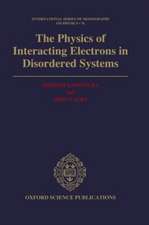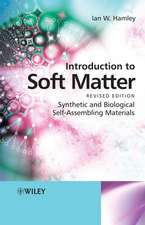Nanostructured Soft Matter: Experiment, Theory, Simulation and Perspectives: NanoScience and Technology
Editat de A.V. Zvelindovskyen Limba Engleză Hardback – 27 iul 2007
Din seria NanoScience and Technology
- 24%
 Preț: 905.79 lei
Preț: 905.79 lei - 18%
 Preț: 1123.35 lei
Preț: 1123.35 lei - 18%
 Preț: 964.71 lei
Preț: 964.71 lei - 18%
 Preț: 1121.76 lei
Preț: 1121.76 lei - 15%
 Preț: 655.60 lei
Preț: 655.60 lei - 18%
 Preț: 1390.11 lei
Preț: 1390.11 lei - 18%
 Preț: 954.31 lei
Preț: 954.31 lei - 15%
 Preț: 645.79 lei
Preț: 645.79 lei - 18%
 Preț: 953.03 lei
Preț: 953.03 lei - 18%
 Preț: 945.79 lei
Preț: 945.79 lei - 15%
 Preț: 639.90 lei
Preț: 639.90 lei - 18%
 Preț: 1109.16 lei
Preț: 1109.16 lei - 23%
 Preț: 779.87 lei
Preț: 779.87 lei - 18%
 Preț: 944.99 lei
Preț: 944.99 lei - 18%
 Preț: 957.62 lei
Preț: 957.62 lei - 18%
 Preț: 1232.26 lei
Preț: 1232.26 lei - 18%
 Preț: 960.30 lei
Preț: 960.30 lei - 15%
 Preț: 646.62 lei
Preț: 646.62 lei - 18%
 Preț: 1249.31 lei
Preț: 1249.31 lei - 15%
 Preț: 636.80 lei
Preț: 636.80 lei - 18%
 Preț: 1232.26 lei
Preț: 1232.26 lei - 24%
 Preț: 821.43 lei
Preț: 821.43 lei - 18%
 Preț: 948.92 lei
Preț: 948.92 lei - 24%
 Preț: 1827.89 lei
Preț: 1827.89 lei - 18%
 Preț: 951.91 lei
Preț: 951.91 lei - 24%
 Preț: 794.21 lei
Preț: 794.21 lei - 18%
 Preț: 953.03 lei
Preț: 953.03 lei - 23%
 Preț: 782.55 lei
Preț: 782.55 lei - 18%
 Preț: 952.57 lei
Preț: 952.57 lei - 18%
 Preț: 948.16 lei
Preț: 948.16 lei - 18%
 Preț: 954.93 lei
Preț: 954.93 lei - 24%
 Preț: 809.40 lei
Preț: 809.40 lei - 23%
 Preț: 781.25 lei
Preț: 781.25 lei - 18%
 Preț: 954.93 lei
Preț: 954.93 lei - 18%
 Preț: 1830.34 lei
Preț: 1830.34 lei - 15%
 Preț: 641.71 lei
Preț: 641.71 lei - 18%
 Preț: 1228.96 lei
Preț: 1228.96 lei - 18%
 Preț: 1120.37 lei
Preț: 1120.37 lei - 18%
 Preț: 956.81 lei
Preț: 956.81 lei - 15%
 Preț: 592.59 lei
Preț: 592.59 lei - 18%
 Preț: 953.65 lei
Preț: 953.65 lei - 18%
 Preț: 954.62 lei
Preț: 954.62 lei - 18%
 Preț: 955.25 lei
Preț: 955.25 lei - 18%
 Preț: 959.19 lei
Preț: 959.19 lei - 18%
 Preț: 953.35 lei
Preț: 953.35 lei - 18%
 Preț: 786.84 lei
Preț: 786.84 lei
Preț: 971.01 lei
Preț vechi: 1184.16 lei
-18% Nou
Puncte Express: 1457
Preț estimativ în valută:
185.81€ • 198.69$ • 154.92£
185.81€ • 198.69$ • 154.92£
Carte tipărită la comandă
Livrare economică 17 aprilie-01 mai
Preluare comenzi: 021 569.72.76
Specificații
ISBN-13: 9781402063299
ISBN-10: 1402063296
Pagini: 628
Ilustrații: XII, 628 p.
Dimensiuni: 155 x 235 x 32 mm
Greutate: 1.18 kg
Ediția:2007
Editura: SPRINGER NETHERLANDS
Colecția Springer
Seria NanoScience and Technology
Locul publicării:Dordrecht, Netherlands
ISBN-10: 1402063296
Pagini: 628
Ilustrații: XII, 628 p.
Dimensiuni: 155 x 235 x 32 mm
Greutate: 1.18 kg
Ediția:2007
Editura: SPRINGER NETHERLANDS
Colecția Springer
Seria NanoScience and Technology
Locul publicării:Dordrecht, Netherlands
Public țintă
ResearchCuprins
Experimental Advances.- Microemulsion Templating.- Nanofabrication of Block Copolymer Bulk and Thin Films: Microdomain Structures as Templates.- Characterization of Surfactant Water Systems by X-Ray Scattering and 2H NMR.- Polyelectrolyte Diblock Copolymer Micelles: Small Angle Scattering Estimates of the Charge Ordering in the Coronal Layer.- Structure and Shear-Induced Order in Blends of a Diblock Copolymer with the Corresponding Homopolyme.- Electric Field Alignment of Diblock Copolymer Thin Films.- Control of Block Copolymer Microdomain Orientation from Solution using Electric Fields: Governing Parameters and Mechanisms.- Structure and Dynamics of Cylinder Forming Block Copolymers in Thin Films.- Mathematical and Theoretical Approaches.- Mathematical Description of Nanostructures with Minkowski Functionals.- Scaling Theory of Polyelectrolyte and Polyampholyte Micelles.- The Latest Development of the Weak Segregation Theory of Microphase Separation In Block Copolymers.- Coarse-Grained Modeling of Mesophase Dynamics in Block Copolymers.- Effective Interactions in Soft Materials.- Computer Simulations.- Ab-initio Coarse-Graining of Entangled Polymer Systems.- Computer Simulations of Nano-Scale Phenomena Based on the Dynamic Density Functional Theories: Applications of SUSHI in the OCTA System.- Monte Carlo Simulations of Nano-Confined Block Copolymers.- Understanding Vesicles and Bio-Inspired Systems with Dissipative Particle Dynamics.- Theoretical Study of Nanostructured Biopolymers Using Molecular Dynamics Simulations: A Practical Introduction.- Understanding Liquid/Colloids Composites with Mesoscopic Simulations.
Textul de pe ultima copertă
This book provides an interdisciplinary overview of a new and broad class of materials under the unifying name Nanostructured Soft Matter. It covers materials ranging from short amphiphilic molecules to block copolymers, proteins, colloids and their composites, microemulsions and bio-inspired systems such as vesicles. The book considers several fundamental questions, including: how self-assembly of various soft materials with internal structure at the nanoscale can be understood, controlled and in future used in the newly emerging field of soft nanotechnology. The book offers readers a view on the subject from different perspectives, combining modern experimental approaches from physical chemistry and physics with various theoretical techniques from physics, mathematics and the most advanced computer modelling. It is the first book of this sort in the field. All chapters are written by leading international experts, bringing together experience from Canada, Germany, Great Britain, Japan, the Netherlands, Russia, Singapore, Spain and the USA. The book is oriented towards active researchers as well as undergraduate and graduate students.
Caracteristici
An interdisciplinary view on a new and broad class of materials under the unified name of “nanostructured soft matter” Offers the first description of the freeware SUSHI















